Is twice-around-the-clock triathlon’s next big thing?
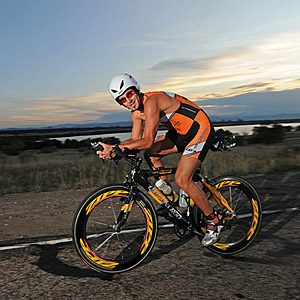
After all his competitive adventure racing success – multiple wins at the Eco Challenge, Raid Gauloise, Primal Quest, X-Games — plus his expertise at laying out great adventure race course on four continents, including the Mild Seven adventure stage race in China, you might wonder what Ian Adamson was doing here.
Here was the Cherry Creek State Park and reservoir in Aurora, Colorado. What the man known as the “toughest man on the planet” was doing was emceeing and race directing the third annual 24 Hours of Triathlon.
On this Labor Day weekend, a group of 400 triathletes and duathletes were competing with water skiers and sunbathers and picnickers for space at the Cherry Creek Reservoir during the day. And at night, after the quarter-mile swim course was closed for safety, they donned coal miner-style headlamps to charge around a 11.2-mile bike layout and a 2.6-mile run course trying to tote up more laps than the rest of their slightly unhinged colleagues.
Unlike the round-the-clock classic endurance sports car races at LeMans and Daytona, Ian Adamson’s 24 Hours of Triathlon is completely human powered. And unlike the high-speed, carbon-powered spectacles in Florida and France, there aren’t huge crowds at Cherry Creek Reservoir — yet.
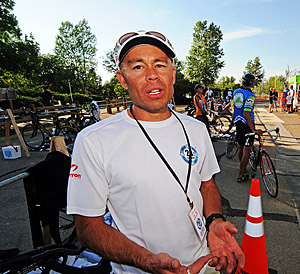
But Ian Adamson, who was one of the stars of adventure tracing who helped Mark Burnett jump start his fabulous TV career with the Eco-Challenge races that eventually morphed into the Survivor franchise, is happy with this year’s sold-out crowd of 400 entrants. That's because in the first year of his enterprise, Adamson went $100,000 in the red when his inaugural contest held at the Boulder Reservoir drew only three dozen entries. “Because our course included several local and county municipalities, and our police and fire safety costs were spread over three work shifts, those costs alone totaled over $30,000,” said Adamson.
He also faced inertia in the fast-growing triathlon community. “The thing I know is that if any multisport race director and promoter wants to hit it big, he or she must offer an exciting new idea,” said Adamson. “The Ironman is covered, and so are race series like Life Time Fitness and ITU racing. From my experience in adventure racing, I can see that there is a hunger for an extended team and individual competition that doesn’t require competitors to make a large investment in equipment nor extensive land use and public safety permits for the promoter. I believe that a race like the 24 Hours of Triathlon is an adventure that tests everyone’s physical and mental limits in close proximity to family and friends and fans.”
Adamson, who has retired from adventure racing competition, has bet his proverbial house on his 24 hours of Triathlon concept. While the Australian-born Adamson was among the elite of adventure racers, he was never a snooty elitist. A few years ago, he competed in a 24-hour ultra-marathon held in a parking lot. All through his adventure racing career, he studied Mark Burnett’s recipe for television ratings success and gained a tremendous amount of behind-the-scenes knowledge and instinct for choosing the most beautiful, exciting backdrops and leading camera crews toward the best developing story lines.
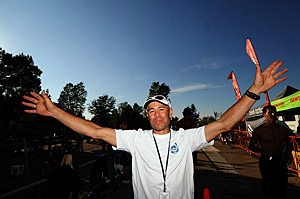
This is why Adamson virtually assumed the role of producer for last year’s highly successful high definition broadcast of the second 24 Hours of Triathlon. He found the personal stories, the camera positions that brought it to life – even within a sprint-sized lap course without the exquisite, romantic beauty of the lava fields or the jungles. And, drawing upon a decade or connections, he found the sponsors to give his event a professional sheen.
With his own very small fortune earned on the toughest trails in the snake infested jungles of New Guinea, the frostbitten heights of the Himalayas and along the piranha-ridden rapids of South American adventure races, Adamson made some more clutch decisions before year two of the 24 Hours of Triathlon franchise rolled along. First he aimed to draw a businesslike line between the raw, inaccessible-without-armies-of-helicopters beauty of the best adventure races and the hamster-in-a-spinning-cage aspect of the Deca-Ironman in Mexico where competitors slog through a million laps in a pool, pedal like zombies around a 1-mile track and run a jillion laps around a track. The aim was to be inclusive – no course too tough for novices and families, no course without moderate beauty and challenge so as not to repel great endurance athletes.
His choice was the Cherry Creek State Park in Aurora, Colorado, a few miles south of downtown Denver. With all roads under the authority of the state park, there was little traffic and complete cooperation with the rangers. Parking was tough, but extensive enough to cover all the competitors and race support. The water natural for the swim, the bike route had moderate hills and interesting corners, while the run path had enough shade trees and mild elevation changes to keep the runners happy.
And with enough good sponsors who trusted his reputation for putting on excellent events, and perhaps wanting to get in on the ground floor of the next big thing, he was able to offer $5,000 in prize money. Presenting sponsor Suzuki pitched in with shuttle service to and from the race headquarters in Cherry Creek State Park during the packed Labor Day weekend. And thanks to Newton Running, the 24 Hours of Triathlon was also able to offer $155 running shoes to the first 200 entrants – an offer which belongs in the goody bag Hall of Fame. “Newton is a great sponsor,” said Adamson. “They realize this event needs time to grow and they are willing to ride it out.” Helping the process along would be a little historical perspective. The first triathlon put on by the San Diego Track Club on Fiesta Island had 46 finishers. The first two Iron Man triathlons had 15 entries and only hit 100 in its third year.
And while Adamson could not nail down television coverage this season, perhaps a little word of mouth about the hot competition might help keep the twice-around-the-clock triathlon dream alive.
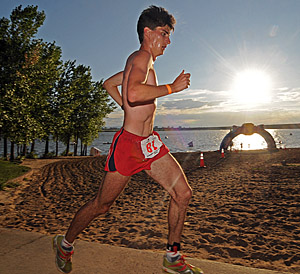
In the 24 hour Male Team of 2 category, Nicholas and Jess Alexander’s Team Gripped Films / Kenda and Team Hersey / Nachmann both completed 21 triathlons and settled things with one more swim leg. At the end, the Alexanders triumphed by a mere 3 minutes 18 seconds – an eyelash in 24 Hour Triathlon terms.
Even closer was the contest for third place in the 24 Hour Triathlon Male Team of 3 Category. Team Die Triing Again – manned by Andrew Graziano, Bill Ledden and Tim Sells – squared off against Team 1 More Than You’s Winfield Hartley, Kevin Callahan and Brian Young. After 20 full triathlons and one additional swim leg, it all came down to a final 11.2-mile bike and at the line Team Die Triing prevailed by a mere 1 minute and 52 seconds.
But topping all of these finish line dashes was the battle for the final spot on the podium the 24 hour Triathlon team of Four. Once again, after 20 full triathlons and 1 additional swim, Team Fartlek engaged in a Michael Phelps-close battle to the finish against Team Racers Against Childhood Cancer. When the tumult and shouting were over, Fartlek defeated racers Against Childhood Cancer by a mere 15 seconds.
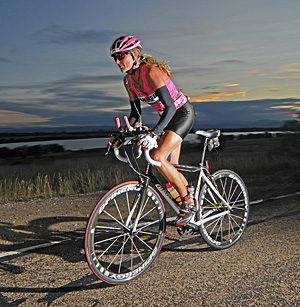
The two solo crowns had $1,000 first prizes at stake, and nothing for the runner-up. In the men’s contest, 2007 Ultraman World Championship third place finisher and revered tri coach Tim Sheeper covered 252.96 miles for the win. Sheeper whipped runner-up Richard Kylberg by 28 miles, but missed Joe McDaniel’s 2006 course record by 14 miles.
The women’s solo pitted Brazilian 25-29 contender Kassiana Rosso against 4-time Ultraman Champ and 2006 Race Across America solo women’s champ Shanna Armstrong of Lubbock, Texas, with Kirsten Kempe right on both of their fleet and enduring heels. At the end, all three had covered 16 full triathlons. Armstrong managed to tuck in one more swim before the bell rang at 24 hours. But Rosso upset the well-regarded ultra athlete and took the win by adding one more bike loop. Rosso collected the $1,000 check, and had the satisfaction of breaking 2007 winner Iona MacKenzie’s course record by 33 miles.
“I enjoyed it, but I think there were too many Type A obsessive triathletes out there,” said Armstrong. “When the Brazilian gal passed me, she didn’t say a word. That reminded me why I chose to do Ultra races. Ultra people are family and much more laid back, friendly and loosy-goosy.” In fact, Armstrong gave a whoop and stopped her bike on lap six to give a kiss to an old friend by the side of the road, showing the type As what Ultraman, RAAM, and Badwater spirit is all about.
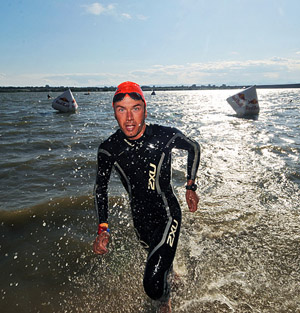
This year’s big payoff of $2,999.99 in the 3-person relay was garnered by Team Retul – which included last year’s winning team member Steven Waite, a pro triathlete from Australia, advertising sales executive Lars Finanger of Boulder, Colorado, and 22-year-old Denver University law student John Gaudette. When they were done, Team Retul had covered 365.28 miles, breaking the record of 330 miles set by Waite, Karen Melliar-Smith and Adam Chase of Team Go Fast a year ago.
This year’s 24 Hours of Triathlon drew teams from several foreign countries and both coasts of the United States. Now that he has survived the first few years, built momentum, and broken even on his big bet on the next big thing in triathlon, Ian Adamson is looking forward to next year’s 24 Hours – and cutting himself that first check.
24 Hours of Triathlon
Aurora, Colorado
August 30-31, 2008
S .24mi/ B 11.2 mi/ R 2.6 mi
Results
Solo Men
1. Tim Sheeper M45-49 252.96 miles (18 triathlons plus 1 swim)
2. Richard Kylberg M45-49 224.64 miles (16 triathlons)
3. Keith Jeneski M35-39 210.6 miles (15 triathlons)
Solo Women
1. Kassiana Rosso (Brazil) F25-29 236.08 miles (16 triathlons plus 1 swim 1 bike)
2. Shanna Armstrong (Lubbock, Texas) F30-34 224.88 miles (16 triathlons plus 1 swim)
3. Kirsten Kemper F40-44 224.64 miles (16 triathlons)
Male Team of 3
1. Team Retul – Steven Waite (Australia) Lars Finanger (Boulder CO) John Gaudette (Denver CO) 365.28 miles (26 triathlons plus 1 swim)
Team $20 for a Topoff 320.32 miles (22 triathlons plus 1 swim 1 bike)
2. Team Die Triing Again 292.24 miles (20 triathlons plus 1 swim 1 bike)
Female Team of 3
1. Team 3 de Fumar Chicas 210.6 miles (15 triathlons)
Coed Team of 3
1. Team Powerbar Tri-Oakies 337.20 miles (24 triathlons and 1 swim)
2. Team New Haven Fitness 294.84 miles (21 triathlons)
3. Team Wreck-less 210.6 miles (15 triathlons)
Male Team of 2
1. Team Gripped Films/Kenda 295.08 miles (21 triathlons and 1 swim) 23:39:17
2. Team Hersey/Hachmann 295.08 miles (21 triathlons plus 1 swim) 23:42:35
3. Team Addax 252.96 miles (18 triathlons plus 1 swim)
Coed Team of 2
1. Team OM 264.16 miles (18 triathlons plus 1 swim 1 bike)
1. Team One Dumb Blonde and an Old Guy 193.96 miles (13 triathlons plus 1 swim 1 bike)
Team of 4+
1. Team Sheeper 295.08 miles (21 triathlons plus 1 swim) 23:40:55
2. Team Operation Ground and Pound 295.08 miles (21 triathlons 1 swim) 23:51:30
3. Team Fartlek 292.24 miles (20 triathlons and 1 swim 1 bike) 23:58:04
4. Racers Against Childhood Cancer 292.24 miles (20 triathlons 1 swim 1 bike) 23:58:19
8 Hour Triathlon Solo Male
1. Eric Walker M30-34 98.52 miles (7 triathlons 1 swim)
2. Adam Little M25-29 98.28 mile (7 triathlons)
3. Jim Fuller M55-59 95.68 miles (6 triathlons 1 swim 1 bike)
8 Hours Triathlon Solo Female
1. Wendy Mader F35-39 98.52 miles (7 triathlons 1 swim)
2. Amy Weeden F30-34 70.44 miles (5 triathlons 1 swim) 7:33:09
3. Leah Gaviola F40-44 70.44 miles (5 triathlons 1 swim) 7:45:59
4. Marisela Martinez F25-29 7-0.44 miles (5 triathlons 1 swim) 7:59:17


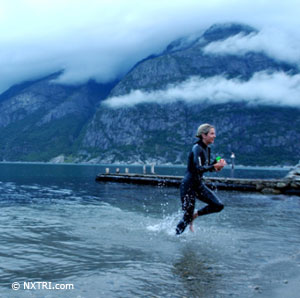
Start the discussion at slowtwitch.northend.network